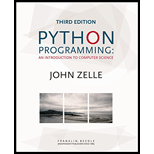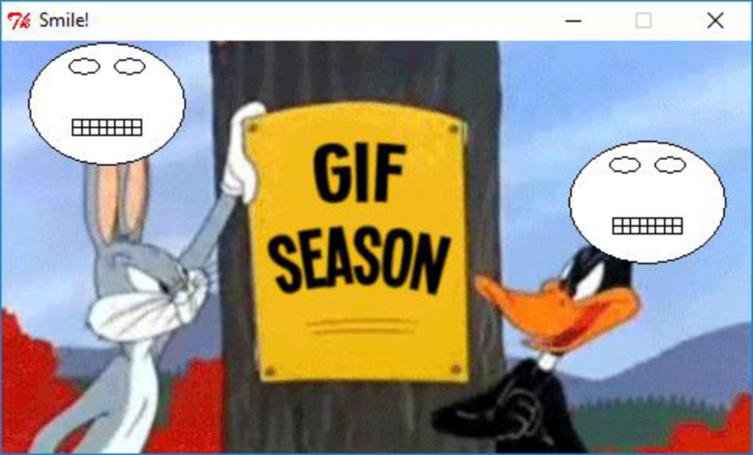
Draw a face
Program plan:
- Import the header file.
- Define the “drawFace” method
- Get the “x” and “y” positions
- Get the “p1” and “p2” positions
- Call the “Oval” method for drawing the face
- Set the color to the face
- Draw the face
- Get the “lc” and “rc” position
- Call the “Circle” method
- Set the color to the face
- Call the “draw” method
- Call the “Circle” method
- Set the color to the face
- Call the “draw” method
- Get the “m1”, “m2”, and “m3” values
- Call the “Rectangle” method
- Set the color to the face
- Call the “draw” method
- Call the “Line” method
- Get the center position
- Get the “x” and “y” position
- Call the “Point” method
- Call the “Line” method
- Call the “draw” method
- Get the “x” and “y” position for different variables
- Calculate “t” and “t1” value
- Call the “Rectangle” method
- Call the “draw” method
- Iterate “i” until it reaches 7
- Clone the teeth by calling “clone” method
- Move the face by calling “move” method
- Call the “draw” method
- Define the main method.
- Read the filename from the user
- Get the image width and height from the file
- Set the graph win size
- Set the coords for graph
- Draw the face
- Get the number of faces from the user
- Iterate “i” until it reaches “n” value
- Get the mouse action
- Call the “drawFace” method
- Call the function “main()”.
This Python program is used to get the GIF (Graphic Interchange format) file and draw the smileys when the user clicking the GIF image.
Explanation of Solution
Program:
#import the header file
from graphics import *
#definition of "drawFace" method
def drawFace(center, size, window):
#get the "x" value
x1 = center.getX()
#get the "y" value
y1 = center.getY()
#get the "p1" value
p1 = Point(x1-(.7 * size), y1 - size)
#get the "p2" value
p2 = Point(x1+(.7 * size), y1 + size)
#call the "Oval" method
head = Oval(p1, p2)
#fill the color
head.setFill("white")
#call the "draw" method
head.draw(window)
#get the "lc" value
lc = Point(x1 - .2 * size, y1 + .6 * size)
#get the "rc" value
rc = Point(x1 + .2 * size, y1 + .6 * size)
#call the "Circle" method
leftEye = Circle(lc, .13 * size)
#fill the color
leftEye.setFill("white")
#call the "draw" method
leftEye.draw(window)
#call the "Circle" method
rightEye = Circle(rc, .13 * size)
#fill the color
rightEye.setFill("white")
#call the "draw" method
rightEye.draw(window)
#get the "m1" value
m1 = Point(x1 - .3 * size, y1 - .5 * size)
#get the "m2" value
m2 = Point(x1 + .3 * size, y1 - .25 * size)
#get the "m3" value
m3 = Point(x1 + .3 * size, y1 - .5 * size)
#call the "Rectangle" method
mouth = Rectangle(m1, m2)
#fill the color
mouth.setFill("white")
#call the "draw" method
mouth.draw(window)
#call the "Line" method
leftLip = Line(m1, Point(x1- .3 * size, y1 - .25 * size))
#get the center position
mLeftCent = leftLip.getCenter()
#get the "x" position
mLCx = mLeftCent.getX()
#get the "y" position
mLCy = mLeftCent.getY()
#call the "Point" method
mRightCent = Point(x1 + .3 * size, mLCy)
#call the "Line" method
lip = Line(mLeftCent, mRightCent)
#call the "draw" method
lip.draw(window)
#get the "x" positions
m1x = m1.getX()
m3x = m3.getX()
#get the "y" positions
m1y = m1.getY()
m2y = m2.getY()
#calculate the "t" value
t = m1x - m3x
#calculate the "t1" value
t1 = Point(m1x - (1/8 * t), m2y)
#call the "Rectangle" method
teeth = Rectangle(m1, t1)
#call the "draw" method
teeth.draw(window)
#iterate "i" until it reaches 7
for i in range (7):
#clone the face
t2 = teeth.clone()
#call the "move" method
t2.move(-i * (1/8 * t), 0)
#call the "draw" method
t2.draw(window)
#definition of main method
def main():
#get the input filename from the user
fname = input("Enter filename: ")
infile = Image(Point(10, 10), fname)
#get the width of the image
wWidth = infile.getWidth()
#get the height of the image
wHeight = infile.getHeight()
#set graph win name
window = GraphWin('Smile!', wWidth,wHeight)
#set the coords
window.setCoords(0, 0, 20, 20)
#draw a smiley
infile.draw(window)
#get how many faces the user wants to draw
n = eval(input("How many faces should we block? "))
#iterate "i" until it reaches "n"
for i in range(n):
#get the mouse action
point = window.getMouse()
#draw a face by calling the method "drawFace"
drawFace(point, 3, window)
#call the "main" method
main()
Output:
Enter filename: test_img.gif
How many faces should we block? 2
>>>
Screenshot of “Smile!” window

Want to see more full solutions like this?
Chapter 6 Solutions
Python Programming: An Introduction to Computer Science, 3rd Ed.
- 2:21 m Ο 21% AlmaNet WE ARE HIRING Experienced Freshers Salesforce Platform Developer APPLY NOW SEND YOUR CV: Email: hr.almanet@gmail.com Contact: +91 6264643660 Visit: www.almanet.in Locations: India, USA, UK, Vietnam (Remote & Hybrid Options Available)arrow_forwardProvide a detailed explanation of the architecture on the diagramarrow_forwardhello please explain the architecture in the diagram below. thanks youarrow_forward
- Complete the JavaScript function addPixels () to calculate the sum of pixelAmount and the given element's cssProperty value, and return the new "px" value. Ex: If helloElem's width is 150px, then calling addPixels (hello Elem, "width", 50) should return 150px + 50px = "200px". SHOW EXPECTED HTML JavaScript 1 function addPixels (element, cssProperty, pixelAmount) { 2 3 /* Your solution goes here *1 4 } 5 6 const helloElem = document.querySelector("# helloMessage"); 7 const newVal = addPixels (helloElem, "width", 50); 8 helloElem.style.setProperty("width", newVal); [arrow_forwardSolve in MATLABarrow_forwardHello please look at the attached picture. I need an detailed explanation of the architecturearrow_forward
- Information Security Risk and Vulnerability Assessment 1- Which TCP/IP protocol is used to convert the IP address to the Mac address? Explain 2-What popular switch feature allows you to create communication boundaries between systems connected to the switch3- what types of vulnerability directly related to the programmer of the software?4- Who ensures the entity implements appropriate security controls to protect an asset? Please do not use AI and add refrencearrow_forwardFind the voltage V0 across the 4K resistor using the mesh method or nodal analysis. Note: I have already simulated it and the value it should give is -1.714Varrow_forwardResolver por superposicionarrow_forward
- Describe three (3) Multiplexing techniques common for fiber optic linksarrow_forwardCould you help me to know features of the following concepts: - commercial CA - memory integrity - WMI filterarrow_forwardBriefly describe the issues involved in using ATM technology in Local Area Networksarrow_forward
 C++ Programming: From Problem Analysis to Program...Computer ScienceISBN:9781337102087Author:D. S. MalikPublisher:Cengage Learning
C++ Programming: From Problem Analysis to Program...Computer ScienceISBN:9781337102087Author:D. S. MalikPublisher:Cengage Learning EBK JAVA PROGRAMMINGComputer ScienceISBN:9781337671385Author:FARRELLPublisher:CENGAGE LEARNING - CONSIGNMENT
EBK JAVA PROGRAMMINGComputer ScienceISBN:9781337671385Author:FARRELLPublisher:CENGAGE LEARNING - CONSIGNMENT Programming with Microsoft Visual Basic 2017Computer ScienceISBN:9781337102124Author:Diane ZakPublisher:Cengage Learning
Programming with Microsoft Visual Basic 2017Computer ScienceISBN:9781337102124Author:Diane ZakPublisher:Cengage Learning Microsoft Visual C#Computer ScienceISBN:9781337102100Author:Joyce, Farrell.Publisher:Cengage Learning,Programming Logic & Design ComprehensiveComputer ScienceISBN:9781337669405Author:FARRELLPublisher:Cengage
Microsoft Visual C#Computer ScienceISBN:9781337102100Author:Joyce, Farrell.Publisher:Cengage Learning,Programming Logic & Design ComprehensiveComputer ScienceISBN:9781337669405Author:FARRELLPublisher:Cengage C++ for Engineers and ScientistsComputer ScienceISBN:9781133187844Author:Bronson, Gary J.Publisher:Course Technology Ptr
C++ for Engineers and ScientistsComputer ScienceISBN:9781133187844Author:Bronson, Gary J.Publisher:Course Technology Ptr





